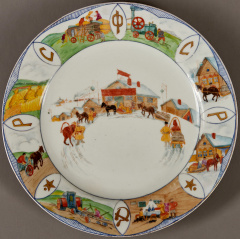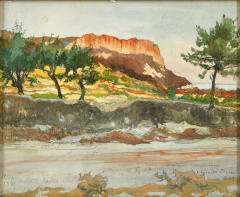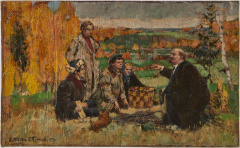Artist of the week: léonard Foujita
In 2011, the Pushkin Museum Pushkin organized the exhibition "Paris school. 1905-1932. From museums and private collections in Paris, Geneva and Moscow. " The exhibition has become an event in the cultural life of our city, in Volkhonka billowing turn, issued a posh location. On the cover of the catalog - a fragment of "Tamer of lions" (1930), Leonard Fujita, an internationally known artist, which, though little known in our country. The uniqueness and the secret of success of the Paris School - in the organic co-existence of different nationalities and cultures - the Scandinavians, French, German, Russian, Ukrainians, Jews, Spaniards, and even the Japanese. On one of the most prominent of them - our story.
Leonard (Tsuguharu) Fujita was born in 1886 in Tokyo to a noble family, descended from the master samurai. It is known that his father was a doctor, and he was a child wanted to be a painter. In 1910, Fujita finishes National University of Fine Arts and Music in Tokyo. By this time, he did not just graduate, but rather a successful artist - winner of several medals and prizes, and even the Japanese emperor bought one of his paintings. And during a trip to Korea in 1911, he was asked to paint a portrait of King.
In 1912, Fujita was going to London, where he met with European art, and in 1913 persuaded his father to let him live in Paris and moved to the capital of world culture.
| Leonard Fujita Self-portrait in the studio. 1932 silk, watercolor, pencil, ink. 68 x 85,7 Estimate: 325 000-375 000 Result: 380 000 Sotheby's. 03.11.2011 Source: sothebys.com |
From the first day in Paris, he is completely absorbed French culture and art. His goal, however, is not to take over the French style, and update the style of Japanese painting. That is, to call it by a French artist is not quite correct - he did a Japanese artist in France. Even his studio was more Japanese than French: it was the mat, pillows, low lacquered table, paper lantern, a giant kettle for tea ceremony. Ehrenburg in his memoirs recalls it as a Japanese artist, strolling hand-woven in a kimono.
In the 1910s Montmartre has largely lost its status as a symbol of artistic Paris, the center of European and world art life by taking over the baton from Montmartre, Montparnasse became gradually, and in 1914 G. Apollinaire in "Paris Journal" said: Montparnasse took the place of Montmartre. Settling in 1913 in the street Forger, a low-cost area of Montparnasse, in the studio right above Modigliani, Fujita soon became a regular at "Rotunda" and all the major parties Montparnasse. He takes dance lessons Isadora Duncan and her brother Raymond. he is seen "in the Greek chlamys goeth down" - Raymond Duncan and his sacrament to naturism, so to say, primitive desire for simplicity of life. Fujita and without naturism was outwardly a very colorful, Crespel calls him "Monsieur Wisteria Elysees, the good half a century ahead of his hippie beads and earrings».
rather quickly Fujita, obzhivshiysya in Paris, is a Modigliani's circle of friends, Pasco, , and all the artists who later would be called representatives of the School of Paris.
The very notion came in 1925 - the Parisian critic Andre Varney united under this name came to Paris artists from other countries. However, it should be noted that in the Paris school, though in the minority, present and French artists.
to the artists of the Paris School decided (quite arbitrarily) classified the French Leger, Vlaminck, Andre Lhote, Spanish Picasso, Juan Gris, Marie Blanchard, Italian Modigliani, immigrants from the Russian Empire Marc Chagall , Chaim Soutine , Larionov , Natalia Goncharova , David Shterenberg , Pinkhus flint , Adolf Federation , Maria Vasilyeva , Marevna , Alexander Archipenko , , Leo Indenbaum , Khan Orlov , Moses Moses Kisling , Louis Marcoussis , Leopold Leopold Gottlieb , Eugene Zak , Jacques Lipschitz , the Japanese Fujita and Kawashima, the Norwegian artist Per Krogh, Bulgarian Pasco, Brancusi, a Romanian and a number of other artists - from the most important to those whose names have been preserved only in the House book Montparnasse 1910-30's .
Fujita was one of the most acclaimed and financially successful (in life), representatives of the company (along with Picasso and Chagall). Some researchers believe that it is his incredibly successful first solo exhibition in 1918 was the beginning of the Golden Age of Montparnasse. In any case, after it he became one of the highest paid artists of the Paris School.
in Paris during the war, art lost much in price - do not buy paintings, preferring to watch from the sidelines for the further development events. In spring 1918, Leopold Zborowski (Polish poet, who had come to study literature at the Sorbonne and start selling paintings during World War II to help finance his fellow artists) organized a trip Fujita, Modigliani and Soutine to the south of France to find new customers and to gain money . After spending a few weeks on the beach, they went all the luxury hotels between Monte Carlo and Cannes, offering their guests to buy their work. Except for a few people, no one picked up, although Modigliani nude Zborowski gave just two hundred francs. In the end they succeeded in Marseille deliver buyer-up pictures of fifteen paintings by Italian for five hundred francs.
After the war, with the return of society in Paris, many artists have to confirm their status. In 1922, Fujita regained recognition of the society and financial success. Here's how he recollects in his preface to "Memoirs Kiki" (1929): «I wrote big picture" Nu couche de Kiki "( refers to the work of Nu á la toile de Jouy, 1922. - AI.). Autumn came, and I sent a picture of the "Salon d'Automne" - the first time I put a big picture. In the morning all the buzz about the picture of the newspaper. At noon, I congratulated the Minister. In the evening, the painting was sold for 8,000 francs-known collector, and the public buyer a little late. It was a great success ».
 Leonard Fujita Nu á la toile de Jouy. 1922 canvas. 130 x 195 Source: fondation-foujita.org |
French critics were ecstatic The original combination of Eastern and Western traditions in Fujita. They were fascinated by the way he uses color and light. While most artists preferred brightness and decorative patterns, worked by local flowers and broad brush, palette Fujita was almost monochrome, like a grisaille its smallest and most delicate pastel shades. The salon was just captivated by the glowing skin effect Kiki delicate ivory. This use of different shades of white was like a revelation for people accustomed to the surrounding cacophony of color.
Fuzhite That glow effect achieved with a secret recipe of white paint and the use of traditional Japanese technique of painting directly Tusheva over oil. It is this unbroken line of ink outlining the silhouettes of his figures, and dissolved in a light haze on the path, gave figures Fujita pearly glow and ineffable grace, clarity, and ease to win the audience at a glance.
| Leonard Fujita Two cats. 1957 oil on canvas 24,4 x 33 Estimate: 50 000-70 000 Result: 134 500 Shristie's. 07.05.2011 Source: christies.com |
Since then, his nudes and cats (cats - another frequent subject of his paintings - he has them constantly in motion, gracefully curved, creating air) become immensely popular.
Years later, explaining his long-term fascination with nude, Fujita wrote: «One day I suddenly realized that very few Japanese painting nude woman. In pictures Harunobu or Utamaro (Suzuki Harunobu and Kitagawa Utamaro - author of the famous series of lithographs in the genre of erotic ukiyo-e - images of everyday life of the urban class of the Edo period. - AI .) Barely see only the parts of the hand or a small area of skin near the knee. I realized that they express a sense of the skin only at these locations. I first decided to try to portray the most beautiful of materials: the human skin. Eight years I paint nudes and reached in this truly exceptional success ».
names of those who inspired the creation Fujita and who looks with his paintings and drawings, it is safe to call : famous with Kiki of Montparnasse (her biography - a history of the formation and flourishing of the Paris School, she posed, without exaggeration, almost all those who would later be called artists School of Paris, and she spoke about the people with whom to take her life in Montparnasse, in a memoir ( for which Hemingway broke his vow not to write the foreword), but Fujita - the only one who carried Kiki at the cemetery in March 1953), Fernando Barry and Lucy Baduy, the artist's wife, dubbed them Yuki.
Artist's Model generally loved to be in his studio. After the war, on the outskirts of Montparnasse emerged luxury homes for wealthy artists. Fujita took a mansion with all the then amenities, including a private bathroom, and Artist's Model liked to use it, "once again not to spend money».
interesting history associated with the name of his wife Yuki . It is said that she met Fujita in the "Rotunda" and could not resist his charm. After the wedding night, which lasted for three days in a hotel in Passy, Fujita asked her name. The name "Lucy" he did not like. "You're Yuki -" pink snow "in Japanese," - he said to her.
 Leonard Fujita Yuki, the goddess of snow, 1924 canvas. 126 x 173 Source: arts-museum.ru |
Since 1931, Fujita travels to Latin America , which is also becoming quite popular, successfully visited Brazil and Argentina. In 1937 - back to Japan (there is a version that the reason for this was to avoid paying taxes in France).
During World War Fujita lives in Japan, is a martial artist.
In 1950, he returned to France, continues to paint nudes, and portraits of cats. He is, as before, united in their works of Japanese art style of the XIX century, the traditional techniques of Japanese calligraphy and European medieval motifs with the findings of avant-garde art, but now, as an adult, it is a mixture of styles looks (and is) no longer features fireworks author and acquired over many years of his own creative style.
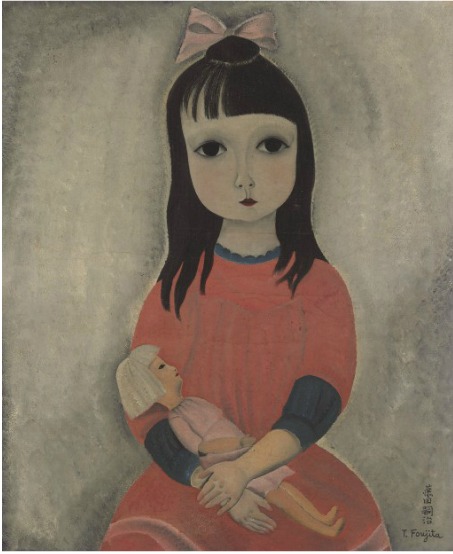 Leonard Fujita A girl with a doll Oil on canvas. 60.6 x 50,2 Estimate: 200 000-300 000 Result: 218 500 Christie's. 06.11.2008 Source: christies.com |
In 1955, Fujita is a French citizen. In 1959 takes Catholicism, and his work appears in a religious theme. And the new technology - he begins to engage in fresco. In the 1960s, he builds and paints the chapel of Our Lady of Reims, called "Chapel Fujita».
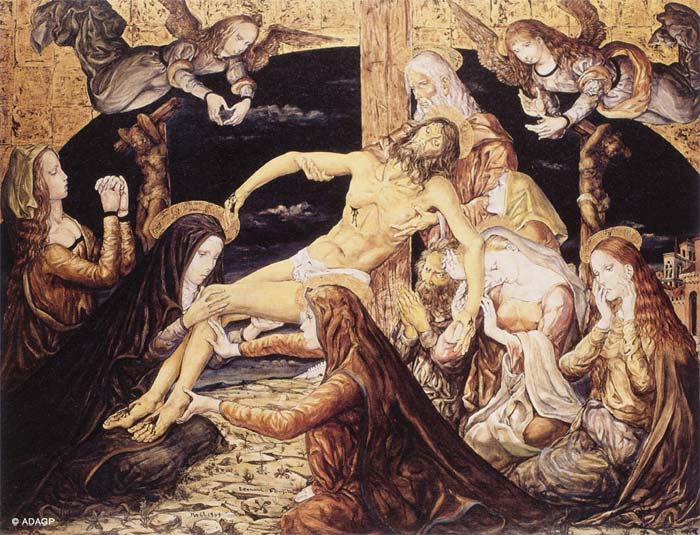 Leonard Fujita The Descent from the Cross. 1959 mural. 150 x 150 Source: fondation-foujita.org |
In 1968, Fujita dies of cancer in Zurich . In 2003, his remains were reburied in the "Chapel of Fujita».
during the Paris school, he was one of the most financially successful of its representatives. Up to 2008 - the most expensive Japanese artist. However, all his best auction results refer to 1989-1990 years. May 16, 1990 "The Girl in the Park" earned $ 5.6 million at Christie's auction in New York. This record was 2.5 million more than the previous achievements Fujita, owned the painting "Children with Doll" (3.1 million dollars at a New York auction Christie's November 14, 1989). Third most expensive paintings Japanese have the painting "Two Sisters", for which the 16 November 1989 at Sotheby's in New York, paid $ 2.1 million.
Despite the fact that Since 1999, prices for the artist did not rise above 950 thousand dollars, Fujita lot and with success - not sold his works remain extremely rare - sold today. For example, in 2012 there were more than 600 auction transactions with his paintings, drawings and mass production. The most expensive painting in 2012 was the "daughter of the artist": the painting was sold June 20 at Sotheby's for 337,250 pounds, the highest price of the year among graphic works Fujita - 133,250 pounds for "Six Graces" - recorded June 21 at Christie's.
| Leonard Fujita The daughter of an artist. 1953 canvas. 44 x 36,5 Estimate: 180 000-250 000 pounds Result: 337,500 pounds Sotheby's. 20.06.2012 Source: sothebys.com | 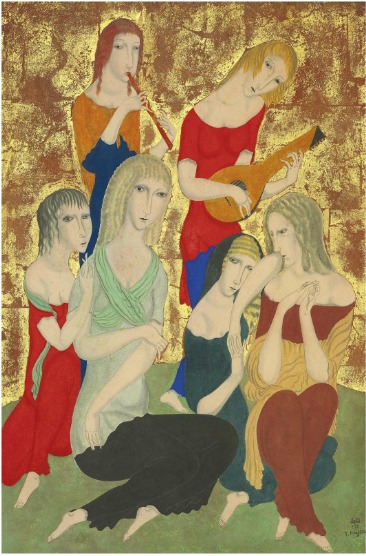 Leonard Fujita Six Graces Gouache and gold leaf. 42.6 x 28,9 Estimate: 70 000-100 000 pounds Result: 133,250 pounds Sotheby's. 21.06.2012 Source: christies.com |
Maria Kuznetsova, AI
Sources:
2. rockkent.narod.ru ;
3. Memoirs Kiki. Foreword. E. Hemingway and Fujita. Per. from English. and French. N. Semoniff. Comm. I. Soboleva. - Salamandra PVV, 2011;
4. Jean Paul Krespel Everyday life in the great era of Montparnasse. 1905-1930 years. Moscow, 2000;
5. I. Ehrenburg People, Years, Life. Moscow, 1990;
6. School of Paris. Exhibition catalog. M., 2011
Permanent link to:
https://artinvestment.ru/en/invest/artistofweek/20130225_fugita.html
https://artinvestment.ru/invest/artistofweek/20130225_fugita.html
© artinvestment.ru, 2024
Attention! All materials of the site and database of auction results ARTinvestment.RU, including illustrated reference information about the works sold at auctions, are intended for use exclusively for informational, scientific, educational and cultural purposes in accordance with Art. 1274 of the Civil Code. Use for commercial purposes or in violation of the rules established by the Civil Code of the Russian Federation is not allowed. ARTinvestment.RU is not responsible for the content of materials submitted by third parties. In case of violation of the rights of third parties, the site administration reserves the right to remove them from the site and from the database on the basis of an application from an authorized body.


